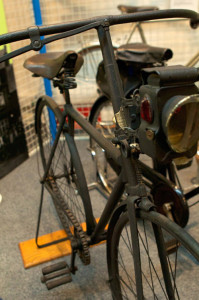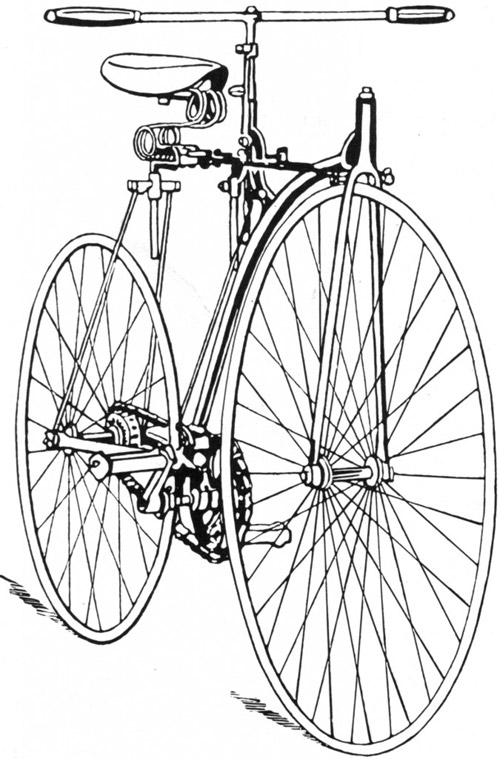 In keeping with the theme of my post from earlier this week, I want to mention another old design that has influenced the bicycle we know today. Actually though, to say that John Kemp Starley’s mid 1880’s Rover safety bike merely influenced all of those that came after it would be a gross understatement. Unlike the ordinaries (aka high-wheelers, penny-farthings) that were popular at the time, the Rover was a rear wheel drive bicycle driven by a chain. Since the gearing was no longer determined by the diameter of the front wheel, the Rover could be adjusted to fit different sized riders. Adjustable sizing and gearing was something new, but that wasn’t the only reason that the bike completely revolutionized the industry at the end of the 19th century.
In keeping with the theme of my post from earlier this week, I want to mention another old design that has influenced the bicycle we know today. Actually though, to say that John Kemp Starley’s mid 1880’s Rover safety bike merely influenced all of those that came after it would be a gross understatement. Unlike the ordinaries (aka high-wheelers, penny-farthings) that were popular at the time, the Rover was a rear wheel drive bicycle driven by a chain. Since the gearing was no longer determined by the diameter of the front wheel, the Rover could be adjusted to fit different sized riders. Adjustable sizing and gearing was something new, but that wasn’t the only reason that the bike completely revolutionized the industry at the end of the 19th century.
The new bikes, with similar sized wheels, were called safeties for a reason. The Wikipedia entry about penny farthings explains one of the hazards of riding one:
“An important and unfortunate attribute of the penny-farthing is that the rider sits high and nearly over the front axle. When the wheel strikes rocks and ruts, or under hard braking, the rider can be pitched forward off the bicycle head-first, called “taking a header” or simply “a header”. Headers were relatively common, and a significant hazard: riders sometimes died from headers. Riders coasting down hills often took their feet off the pedals and put them over the tops of the handlebars, so they would be pitched off feet-first instead of head-first.”
 Unlike those ordinary bikes, a term coined at the time to differentiate high wheeler bicycles from the new safeties, Starley designed the Rover to “place the rider at the proper distance from the ground…to place the seat in the right position in relation to the pedals…to place the handles in such a position in relation to the seat that the rider could exert the greatest force upon the pedals with the least amount of fatigue.”
Unlike those ordinary bikes, a term coined at the time to differentiate high wheeler bicycles from the new safeties, Starley designed the Rover to “place the rider at the proper distance from the ground…to place the seat in the right position in relation to the pedals…to place the handles in such a position in relation to the seat that the rider could exert the greatest force upon the pedals with the least amount of fatigue.”
In a lecture at the Society of Arts in London in 1898, he went on to explain more of the thinking that led to the design of the Rover:
“I had been considering what a man pedalling a bicycle could be compared to… it largely resembled walking up a ladder, but …whereas the pedals went down in the former; the man went up in the latter. I therefore had to determine where the handles should be placed to enable him to bring the whole of his weight on to the pedals…. It was … the handle-bar which compelled me to adopt the present form of machine, as I could not get it sufficiently forward by the other type. It will be seen by the position of the handle-bar on the Ordinary [high-wheeler] bicycle, that it was utterly useless and imperfect for this purpose.’
You can read more about JK Starley, and the first commercially successful safety bike that he created, in a post today at Bike Hub. Today would be his 158th birthday, so the Bike Hub piece features tributes from the world of bicycling (including a quote from me) about Mr. Starley and his contributions to the bike industry and the world.
Cycling sites and blogs are joining in the birthday celebrations today. Posts at BikeBiz, The League of American Bicyclists, and Bike World News are just a few of the ones that I have seen so far. If you are riding a bike today that is not a highwheeler (or a recumbent I guess), I encourage you to spread the word and join the online birthday tributes to the creator of the bicycle as we know it.


Leave a Reply